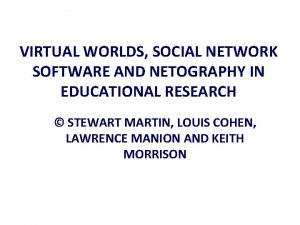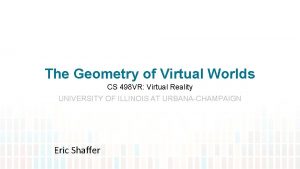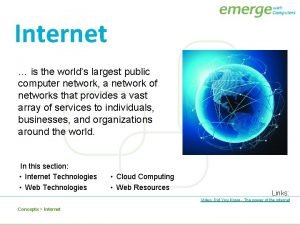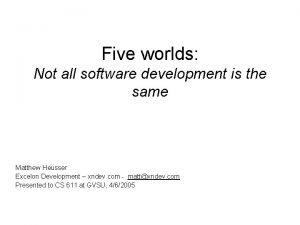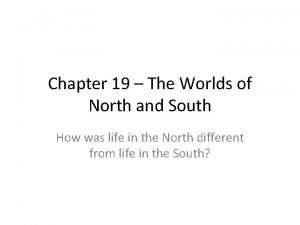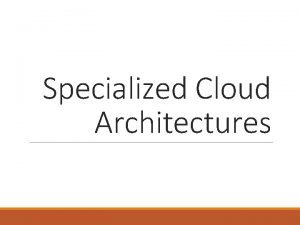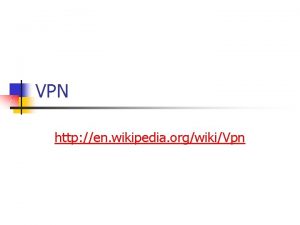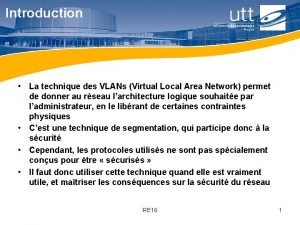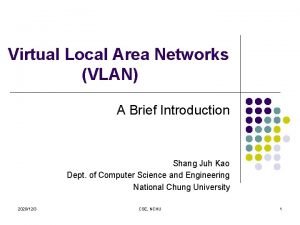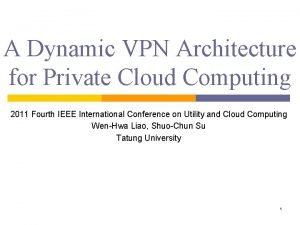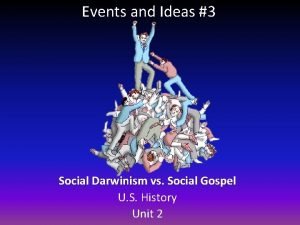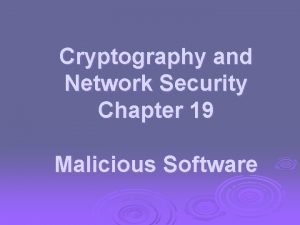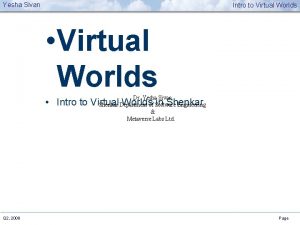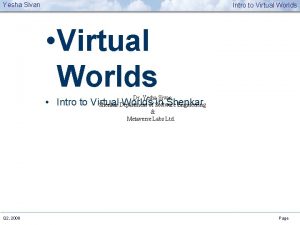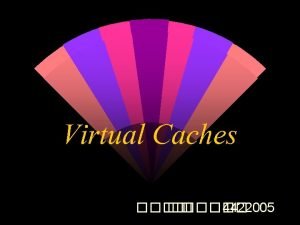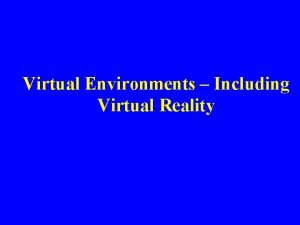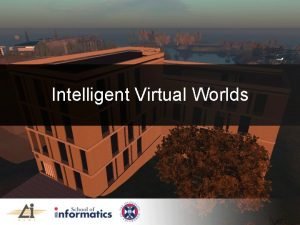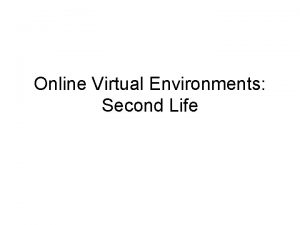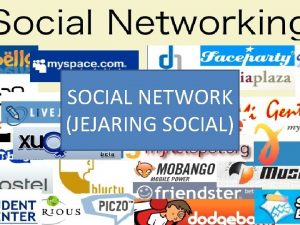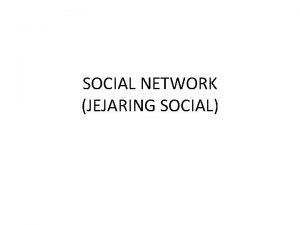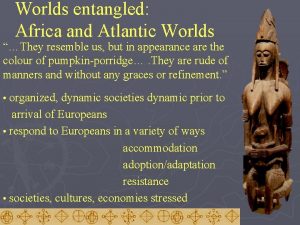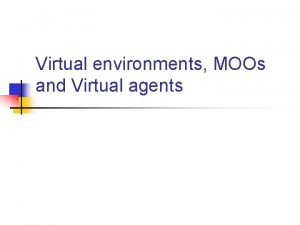VIRTUAL WORLDS SOCIAL NETWORK SOFTWARE AND NETOGRAPHY IN



























- Slides: 27

VIRTUAL WORLDS, SOCIAL NETWORK SOFTWARE AND NETOGRAPHY IN EDUCATIONAL RESEARCH © STEWART MARTIN, LOUIS COHEN, LAWRENCE MANION AND KEITH MORRISON

STRUCTURE OF THE CHAPTER • Key features of virtual worlds • Social network software • Using virtual worlds and social media in educational research • Netography, virtual worlds and social media network software • Opportunities for research with virtual worlds, social network software and netography • Ethics • Guidelines for practice • Data

VIRTUAL WORLDS Computer-based multi-user simulations that are shared online by individuals, who appear as a graphical character: an interactive icon or avatar. Three-dimensional, visually realistic and attractively designed.

VALUABLE VIRTUAL WORLDS • Valuable for stimulating participants’ imagination where the sense of being in a real place may be important, e. g. to encourage engagement in exploring moral dilemmas. • Valuable for investigating socially sensitive issues by invoking a feeling of a ‘safe distance’ between the individual and the thing being explored, as the avatar becomes the presenter of a particular perspective or behaviour.

VALUABLE VIRTUAL WORLDS • Valuable for developing otherwise inaccessible or impossible environments to explore human interaction, agency, values and perceptions, such as historical locations and experiences, future imagined scenarios or uninhabitable settings. These features make virtual worlds particularly effective training environments. • The low risk and ‘repeatability’ of experiences in virtual worlds have advantages because of the safety in otherwise dangerous or unpredictable environments and because they afford discardable experiences at relatively lower personal, experiential or emotional cost.

VIRTUAL WORLDS AND PROJECTION • In a virtual world, individuals can project their actions, views or values through their avatar and receive feedback from others in the system. • Projection techniques can encourage a sense of authenticity to externalize the self and create an impression of presence in an environment of which we are not physically a part. • Virtual worlds provide environments in which participants can project, share and reflect on their own and others’ actions and views, which may lead to the surfacing and exploration of further, often sensitive, issues for investigation and possible resolution, the reconciliation of potential conflict and disagreement, and hence to the development and enlargement of understanding.

ADVANTAGES OF VIRTUAL WORLDS Economy • Cheaper to create and use than real-life settings Visibility • Important things can be made clearer and more accessible Control • Much more control of the setting is possible than in real-life Safety • Risk reduction • Safe distance from the individual and that being explored

ADVANTAGES OF VIRTUAL WORLDS Projection • Provide authenticity Access • Access to dangerous, sensitive or otherwise inaccessible environments and issues Imaginativeness and creativity • Explore imagined scenarios Repeatability • Of experience

SOCIAL NETWORK SOFTWARE Web-based platforms and services that enable individuals to construct a public/semi-public profile within a bounded system. A group of Internet-based applications that enable the creation, blending, re-posting and exchange of content generated by users.

SOCIAL NETWORK SOFTWARE Social networking software • Networking services for sharing personal information • Sites for content sharing or discussion • Forums • Professional networking sites • Blogs • Virtual social worlds • Massive multiplayer online role playing games

USING VIRTUAL WORLDS AND SOCIAL MEDIA IN EDUCATIONAL RESEARCH Virtual worlds and social media can help individuals to communicate more freely and engage in ‘ideal speech situations’ (Habermas): • • • Enter a discourse and check questionable claims Evaluate explanations and assess justifications Modify a given conceptual framework and influence norms Reflect on the nature of political views and action Develop mutual understanding between participants Accept that consensus is derived from the better argument and not from the influence or authority of individual participants • Accept that the cooperative search for truth should be the only motive • Recognise the legitimacy of others to participate in the dialogue as an autonomous and equal partner, and to promote equal opportunity for discussion

USING VIRTUAL WORLDS AND SOCIAL MEDIA IN EDUCATIONAL RESEARCH • Social media offer rich opportunities to study changes to the historical imbalance of power within most educational uses of technology. • Social media offer ways of exploring the space between institutionally managed systems and noninstitutional personal usage. • NB. Participants may prefer to keep their social and academic presences separate.

NETOGRAPHY, VIRTUAL WORLDS AND SOCIAL MEDIA NETWORK SOFTWARE • Netography (network ethnography) relies heavily on observation and, like traditional ethnography, is an immersive and interpretive exploration of a particular space (here of embedded technology). • Sufficient expertise with the environment is a prerequisite for conducting the study. • The persona being portrayed should be consistent and coherent across all digital platforms used. • Consider issues of immersion, participant and nonparticipant observation.

OBSERVATION IN NETOGRAPHY Participant- and non-participant observation • What does ‘participation’ mean? • What exactly is being ‘observed’: interactions which the researcher may have created in part, so are in some senses observing themselves. • The researcher always plays some part in constructing the object of their study.

NETOGRAPHY, VIRTUAL WORLDS AND SOCIAL MEDIA NETWORK SOFTWARE The purpose is empirical description and developing a theoretically rich description that relates to the particular issue or areas of study and connects with wider discussions.

NETOGRAPHY, VIRTUAL WORLDS AND SOCIAL MEDIA NETWORK SOFTWARE Studies may include several sites and different forms of data collection (often using mixed-methods/mixedworlds /mixed-media approaches), e. g. : • Formal interviews • Observing individuals both online and in the physical world (e. g. in cybercafes, game conventions, or whilst physically present but online) • Watching and chatting to members of the online community being studied, or during casual encounters online and offline • Using big data

IDENTIFYING THE ‘FIELDSITE’ OF THE ONLINE COMMUNITY • A ‘fieldsite’ is a collection of places, individuals or practices that might be physical or virtual or some combination of these. • The first task of a researcher studying a community is therefore to clarify what is meant by ‘community’. • Communities within digital environments are often only very loosely bounded and dynamic by nature. • It is important to be able to distinguish who and what is ‘in’ and ‘out’ of the study and how this is to be decided.

CREATING A PRESENCE IN AN ONLINE COMMUNITY • Presence in an online community is often a prerequisite for engagement. • New participants often have to be invited or accepted. • There may be official gatekeepers or a formal arrangement for gaining access – a rite of passage. • Sometimes it may be a case of building an identity and presence in whatever ways the platform allows, and creating an array of connections over time.

OPPORTUNITIES FOR RESEARCH WITH VIRTUAL WORLDS, SOCIAL NETWORK SOFTWARE AND NETOGRAPHY Virtual world and social network platforms are useful for studying: • Contexts where sensitive issues may be the focus • Studying interaction, especially in dynamic, fluid, uncertain or contested contexts • Complex behaviour • Developments over time • Behaviours and attitudes towards others • Contested opinions or beliefs • Individual and self-perceptions in relation to others and how these change over time • Development of understanding, of perception, of processes where negotiated meaning is important • Dynamics that generate consensus and discord • Embodiment, selfhood, globalisation, learning

OPPORTUNITIES FOR RESEARCH WITH VIRTUAL WORLDS, SOCIAL NETWORK SOFTWARE AND NETOGRAPHY Virtual world and social network platforms are useful for studying: • Influence of social media on campus life, identity, sexuality, relationships and attitudes toward ‘others’ • Possible shifts in the roles of learner and teacher • Teacher networking • Student expectations • Peer feedback • Identity presentation and development • Support • Maintaining relationships • Different phases of transition • Exposure to conflicting values

ETHICS • What are public and private data. • How to treat public and private data. • Who, actually, are the participants (issues of confidentiality, anonymity, non-traceability, authenticity, truthfulness). • Consequences for participants: immediate and in the future. • Informed consent. • Vulnerability and individual risk with online identities.

ETHICS • • • Public/private nature of communication. Security and confidentiality. Control of, and access to, data. Overt/covert research. Obtrusive and unobtrusive research. Lurkers and voyeurs.

GUIDELINES FOR PRACTICE • Be alert to unanticipated acts of meaning-making and to how activities make sense to the individuals engaged in them. • Do not assume the existence of boundaries between online and offline fieldsites. • Explore all stages and forms of engagement and use a range of tools for recording and interpretation. • Virtual worlds and social media sites have customs and norms that mediate communication; adopting the perspective of the stranger can help to understand why this may be so or could be otherwise. • Expect a variety of different media and experiences across multiple platforms. • Expect uncertainty: digital spaces often do not provide a single, verifiable or ‘objective’ reality. • Allow sufficient time: familiarity and expertise may be needed to engage with the community and gain acceptance.

GUIDELINES FOR PRACTICE • Ensure anonymity of data, whether participants request it or not. • When participating within a particular group, avoid taking sides; avoid conflict. • Remain alert to the way the researcher’s own agency intrudes in the process of creating an authentic, rich and thick account of the ‘messy reality’ of the digital cultural space as perceived and understood by participants. • Be aware that study participants may have access to the researcher’s own online identity; consider whether and how this may influence the study and plan accordingly. • All forms of misrepresentation or deception are best avoided. • Justify covert observation and/or deception. • Fully understand the protocols, etiquette and common practices of the fieldsite(s) sufficiently to engage and blend in with the community being studied.

GUIDELINES FOR PRACTICE • Ensure you have technical expertise available to support the study. • Decide whether to use a commercial product or to create a purpose-built environment. • Consider: – whether it will meet the research needs; – whether it can be supported by and run effectively on the intended computer system; – whether enough storage is available; – how long recordings will usually be and how many of these might there be; – how much detail is important; – whether advanced editing features will be needed or just a basic package; – testing all software thoroughly.

GUIDELINES FOR PRACTICE • Ensure sufficiently high-quality online availability. • Ensure sufficient bandwidth and safe passage through institutional network firewalls. • Recognize that challenges can emerge when creating common protocols for a research team, e. g. if individuals are based in different institutions or countries, as these may apply different procurement constraints, use dissimilar and sometimes incompatible IT infrastructures, or have policies with very different embedded institutional and cultural assumptions about the nature of academic roles and responsibilities.

GUIDELINES FOR PRACTICE • Ensure a clear and careful link between the research question and the methodological design of the research. • Keep field notes. • Ensure data of all types are time-stamped. • Be open to using both quantitative and qualitative data.
 Virtual world social network
Virtual world social network Worlds together worlds apart 4th edition
Worlds together worlds apart 4th edition Virtual circuit tables
Virtual circuit tables Virtual worlds
Virtual worlds Kid virtual worlds
Kid virtual worlds Internet is the world's largest public lan
Internet is the world's largest public lan Five worlds of software development
Five worlds of software development Has virtual functions and accessible non-virtual destructor
Has virtual functions and accessible non-virtual destructor Social thinking social influence social relations
Social thinking social influence social relations Social thinking social influence social relations
Social thinking social influence social relations Chapter 19 the worlds of north and south
Chapter 19 the worlds of north and south Chapter 24 new worlds the americas and oceania
Chapter 24 new worlds the americas and oceania New worlds the americas and oceania
New worlds the americas and oceania Chapter 20 worlds apart the americas and oceania
Chapter 20 worlds apart the americas and oceania Chapter 24 new worlds the americas and oceania
Chapter 24 new worlds the americas and oceania Features of peer to peer network and client server network
Features of peer to peer network and client server network Network centric computing
Network centric computing Specialized cloud architecture
Specialized cloud architecture Vpn protocols wiki
Vpn protocols wiki Vlan (virtual local area network)
Vlan (virtual local area network) Virtual lan (vlan)
Virtual lan (vlan) Virtual private network
Virtual private network Virtual network management
Virtual network management Compare and contrast social darwinism and social gospel
Compare and contrast social darwinism and social gospel Malicious software in cryptography and network security
Malicious software in cryptography and network security Coa virtual lab iit kharagpur
Coa virtual lab iit kharagpur Vutes
Vutes Eltima software virtual serial port
Eltima software virtual serial port
